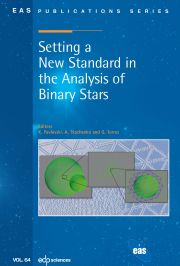No CrossRef data available.
Article contents
QSO Survey and Reference Frame with Gaia
Published online by Cambridge University Press: 15 February 2011
Abstract
The Gaia space astrometric mission will construct its own celestial reference frame basedon thousands of QSO positions measured with an accuracy of a few tens of microarcseconds.For consistency with the current realization of the International Celestial ReferenceFrame, which is based on Very Long Baseline Interferometry (VLBI) positions for more than3000 extragalactic radio sources, it is crucial that the two frames be aligned with thehighest possible accuracy. This alignment requires a number of common objects withexcellent optical and radio astrometric properties. Because of their physical properties,it is possible that the QSO optical and radio positions do not physically coincide at the100 microarcsecond level. While such shifts may affect the accuracy in aligning the twoframes, they may also help gaining insights into the physical conditions in the nuclearregions of these objects. This paper reviews the ongoing work to align the VLBI and Gaiaframes along with the potential astrophysical outcome that may result fromcomparing/combining ultra-accurately these two frames.
Information
- Type
- Research Article
- Information
- European Astronomical Society Publications Series , Volume 45: GAIA: At the Frontiers of Astrometry , 2010 , pp. 345 - 350
- Copyright
- © EAS, EDP Sciences 2011

